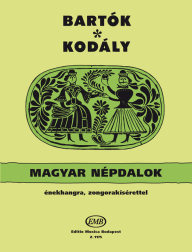The journey of musical works from author to performer
The task of the music publisher is to put manuscripts (be they paper or computerised) into a form that is legible, inspiring, and easy to use for performers; and to ensure the promotion, distribution, and legal use of the works.
With 75 years of experience behind us, we do this honourable work with consideration, commitment, and enthusiasm.
We thank the composers and music teachers who entrust their works to us.
Bartók, Béla

Béla Bartók was born in Nagyszentmiklós, Hungary (now Sânnicolaul-Mare, Romania), on March 25, 1881. His father was director of a government agricultural school, his mother, a teacher and pianist. She gave Béla his first piano lesson on his fifth birthday; his great gifts as pianist soon became evident, and at the age of 9 he began to compose. After the death of his father, they moved to Nagyvárad, Beszterce and Pozsony. He studied piano with László Erkel at Pozsony and composition and piano with János Koessler at the Royal Academy of Music in Budapest.
His first major composition was the symphonic poem Kossuth (1903). Three years later his first work based upon Hungarian peasant music was published: the Twenty Hungarian Folksongs, produced in collaboration with Zoltán Kodály. In 1907 Bartók became professor of piano at the Academy of Music. His tenure lasted nearly 30 years, being interrupted occasionally for folk song research and concert tours. His first wife, Márta Ziegler, and second wife, Ditta Pásztory, were both his piano pupils. He never taught composition, fearing that to do so might endanger his own creative work.
Important Bartók works composed between 1907 and 1922 include the opera Bluebeard's Castle (1911), the First and Second String Quartets (1909, 1918), the ballet The Wooden Prince (1914–1916), the two Violin and Piano Sonatas (1921–1922), and the pantomime The Miraculous Mandarin (1918–1919). After World War I Bartók intensified his career as a concert pianist. He gave the first performances of his first two Piano Concertos (1927, 1930–1931).
He travelled widely in Europe and in 1927 he made his first United States tour, performing a number of his own works to mixed critical reception. Significant compositions of that period include the Two Rhapsodies for violin and piano (1928), the Fourth and Fifth String Quartets (1928, 1934), the Cantata profana (1930), and the earliest books of Mikrokosmos, which is a series of 153 progressive pieces for piano on which Bartók worked from 1926 to 1939. Bartók's artistic intent at that point in his career is excellently summarized in his essay “The Influence of Peasant Music on Modern Music” (1931). He stated emphatically that the composer “has a right to use musical material from all sources. What he has judged suitable for his purpose has become through the very use his mental property... The question of origins can only be interesting from the point of view of musical documentation.”
The highest form of folk-influenced music, Bartók believed, is that in which the folk atmosphere has been completely assimilated. He described such music as follows: “Neither peasant music nor imitations of peasant melodies can be found in his [the composer's] music, but it is pervaded by the atmosphere of peasant music. In this case we may say he has completely absorbed the idiom of peasant music which has become his musical mother tongue.”
The political situation of Hungary became more and more unsettled in the mid-1930s. During this period Bartók produced important works: Music for Strings, Percussion, and Celesta (1936), Sonata for Two Pianos and Percussion (1937), Contrasts for violin, clarinet, and piano (1938), the Violin Concerto (1937–1938), and the Sixth String Quartet (1939).
When Nazi Germany annexed Austria in 1938, he realized he would have to leave Hungary soon. After the death of his mother in 1939 his last tie was broken. The following year Bartók and his wife settled in New York City. He was given a temporary appointment at Columbia University, transcribing the records of Serbo-Croatian folk songs in the Parry Collection, which lasted through 1942. Bartók's persistent ill health and resultant inability to perform publicly or to take another position left his financial situation precarious. Fortunately, he received important commissions, and assistance from the American Society of Composers, Authors, and Publishers. The Concerto for Orchestra (1943) was commissioned by Serge Koussevitzky, the solo Violin Sonata (1944) by Yehudi Menuhin, and the Viola Concerto (1945) by William Primrose. (The last-named work remained unfinished; it was completed by Tibor Serly, one of Bartók's pupils.) Bartók worked on his Third Piano Concerto, which he composed for his wife, until a few days before his death. The last 17 measures were still incomplete when he died of leukaemia on Sept. 26, 1945.
 Deutsch
Deutsch English
English Español
Español Magyar
Magyar Polski
Polski Română
Română Slovenský
Slovenský Slovenščina
Slovenščina 中文
中文





































































































































































